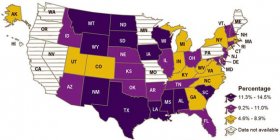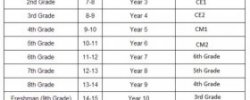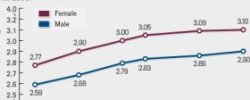The structure of U.S. education includes 12 years of regular schooling, preceded by a year or two of pre-school education, and followed by a four-stage higher education degree system (associate, bachelor's, master's, doctorate) plus various non-degree certificates and diplomas. In addition, there are special education services, adult basic and continuing education, leisure learning programs, and continuing professional education and training programs. Completion of each level or stage is a prerequisite for access to the next, and a variety of assessment and evaluation tools are used to determine learning needs, academic achievement standards, and eligibility to proceed to higher levels of education.
Progressing Through the System
Pre-School Preparation
The majority of U.S. children now begin their educations prior to entering regular school, and most states now require enrollment in pre-school programs and provide such programs. Pre-school programs generally occur in the year preceding school entry and sometimes the previous year as well, or around ages 3-5. The first year of pre-school education is often called pre-kindergarten or nursery school, while the second year is often called kindergarten or preschool. Just under one million children currently enroll in the first year of pre-school education each year, and some 3.4 million enroll in the second.
School Entry
U.S. children enter formal schooling around age 6 (some enter at 5 and others at age 7 depending on the relationship of their birthdate to the school calendar). Over 3.7 million children enter the first grade of school each year.
Duration of School
Formal schooling lasts 12 years, until around age 18 (once again, depending on the age at entry). Each of the school years is called a grade, so that 12th grade corresponds to the 12th year, etc. Nearly 48 million students are enrolled in primary and secondary education in the United States across all grade levels.
Stages/Levels of School
Infant development, pre-school, and frequently the first or second year of formal schooling are collectively termed Early Childhood Education in the United States, and this age range is considered a professional and research specialization for educators. Formal primary education is called Elementary Education and ranges from first grade through grade 4, 5, or 6, depending on state and district regulations. The upper level of primary education is often organized separately into a unit called Middle School, which begins at grade 4, 5, or 6 and ends at grade 6, 7, or 8. Likewise, the lower grades of secondary education (years 7, 8, or 9 depending on state and district regulations) are sometimes organized separately into what is called Junior High School. Regular (including upper) secondary education is called High School, beginning in grade 8, 9, or 10 and ending at grade 12, again depending on state and district regulations.
Compulsory Schooling
Compulsory schooling ends by law at age 16 in 30 states, at age 17 in nine states, and at age 18 in 11 states plus the District of Columbia. Students may drop out of school if they have reached the age set in their state's law for the end of compulsory schooling, but dropouts are not considered to have completed school and no certificate or award is issued at this stage. The U.S. dropout rate is just over 11 percent of secondary-level students age 16 and older.
School Leaving
Two basic school leaving certificates are awarded for completing school, the High School Diploma, awarded to graduates of secondary school, and the GED (General Educational Development) Certificate, awarded to adults who left school but then complete a special supervised study and examination program. High School Diplomas represent a variety of different curricula and standards. Some 2.8 million students are awarded some form of High School Diploma each year, while around 500 thousand adults successfully complete GED programs. The secondary school completion rate is 92.6 percent of those who enroll at the secondary level, while the GED pass rate is 62 percent of those attempting the program.
Some private schools and school districts award certificates at the primary level to students who complete Elementary School or Middle School, although this practice is not uniform across the country.
Special EducationAt the school levels, around 6 million students receive some form of special needs instruction and support for diagnosed disabilities that may affect learning. Special education students are frequently required to stay in compulsory school longer than regular students, usually until age 20 or 21. In addition, some 2.4 million school-age students are enrolled in special programs for the gifted and talented. Students who complete Individual Education Plan (IEP) programs in special education also receive certificates (if the program is not equivalent to secondary graduation) or diplomas (generally equivalent to secondary graduation).
Postsecondary Enrollment
Over 60 percent of graduating secondary students enroll in some form of postsecondary education each year, or approximately 1.8 million students. Twenty per cent enroll on a part-time basis, and 43 percent enroll in associate degree and short programs as compared with bachelor's degree programs.
First Degree Attainment
Recent data show that over 500, 000 students earn associate degrees each year, nearly 150, 000 earn short non-degree certificates and diplomas, and nearly 1.2 million students earn bachelor's degrees. Of the students who initially enroll in short programs and associate degree programs, over 38 percent finish and receive some award, including 6 percent who gain admission to bachelor's degree programs and graduate, but 48 percent drop out. Of the students who initially enroll in bachelor's degree programs around half, or 53 percent, earn a bachelor's degree while 24 percent drop out and the remainder remain on the rolls without completing a degree or switch to another type of program. Since increasing numbers of students temporarily stop their studies and later re-enroll, it is impossible to report precise continuous flow data.







